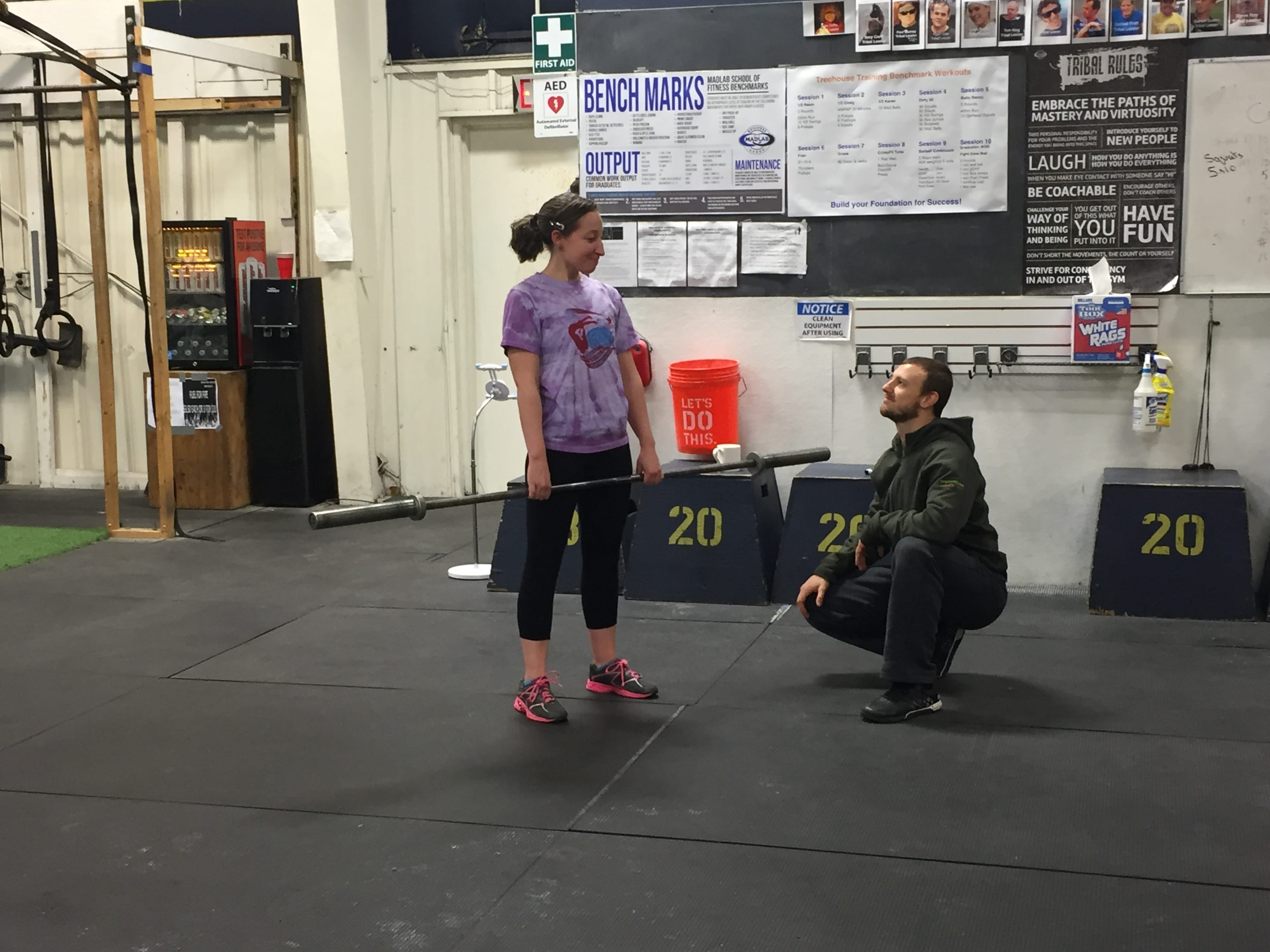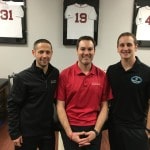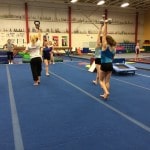The Intern Perspective: The Life of a PT/Gymnastics Intern and My Views on “Bridging the Gap”
This story begins with a simple Google search, purely out of curiosity, with no specific expectations for the results. “Gymnastics physical therapy.” The top result – hybridprspective.com (now SHIFT). That’s how I found out about Dave Tilley a year ago. As a lifelong gymnast, coach, and now physical therapy student, this seemed too good to be true. With only three years under his belt, Dave’s résumé is more impressive than most physical therapists’ résumés after treating for decades. Despite my initial apprehension, I realized that Dave was perusing the same path I had frequently imagined for myself but always thought was too ambitious to actually accomplish. Specializing in treating the niche population of gymnasts and basically bridging the gap between movement science and gymnastics is a phenomenal undertaking.
Thanks to the support and encouragement from my friends, family, and school, I made some personal sacrifices, did a lot of planning, and stepped way outside of my comfort zone to arrange one of my clinical rotations for physical therapy school in Massachusetts with Dave (500 miles from my home in Pennsylvania) – and I have been thrilled since the moment I got here! Dave and I have had an almost nonstop exchange of information and ideas. “Just the babble between two science nerds,” he would joke to his patients, who were occasionally subjected to the lectures.
I would consider my internship very non-traditional, for a physical therapy clinical rotation, mostly because the experience did not end when office hours ended. In fact, some of the most important things I’m taking away from this experience have come from outside of the clinic. Dave’s job is not confined to the clinic or the usual 9-5 office hours, and neither was mine during this internship. Truthfully, it’s more like 5-9, followed by reading, research, and studying, only to repeat again the next day. But we are both working towards goals and working hard for our patients, which makes it worth it.
Table of Contents
In the Clinic:
Dave fulfilled his responsibilities as my PT clinical instructor by reinforcing necessary concepts about physical assessments, developing and progressing treatment plans, giving me hands-on experience with patients, and quizzing me on anatomy and physiology. But his instruction went beyond the basics. In the clinic, he made sure I understood the fundamentals of rehabilitating athletes because, too often, after a certain point, many athletes are not challenged by physical therapy and do not receive the best return-to-sport training.
Dave is earning his board certification in sports rehabilitation and would often share with me what he was learning in his certification course. But above all, Dave taught me about treating gymnasts. He taught me about common pathologies that plague gymnasts, how to screen for them, and how to create a treatment plan that not only targets the immediate condition but can be continued after the gymnast is finished with physical therapy. As healthcare providers and members of the gymnastics community, our goal is for our patients to maintain good physical health.
In the Gym:
The lessons extended from the clinic in to the gym. As a lifelong gymnast and currently a coach, I’d like to think that I know a thing or two about the sport I’m so devoted to, but Dave changed a lot of my perceptions about coaching, training, injury prevention, and gymnastics as a whole. At the gym where he coaches, he and the program director, Eva, let me participate in their team practices. From their warm-up routine through to their conditioning workouts, there are a lot of positives about this gym that jumped out at me. The focus of their warm-up is dynamic stretching rather than static stretching, their event rotations involve numerous stations and drills, even during competition season, and their conditioning program is built on the principles of periodization (a progressive strength program to reach optimal performance in a certain timeframe).
Additionally, Dave has his team track their nutrition, sleep patterns, growth spurts, heart rate, and levels of physical and emotional stress and fatigue on spreadsheets posted in the gym. Rather than focusing on body image, the emphasis of these measurements is on tracking the overall health of his athletes and having them become more self-aware. Along with this, the mentality in the gym is concentrated on accountability for oneself. Every girl knows that attending practice is a choice, participating in conditioning is a choice, and working hard is a choice. Every girl knows that if she wants to improve and be her best, her coaches are already giving her all the tools and she is responsible for the rest. Although gymnastics requires a tremendous amount of discipline, both from oneself and from a structured training program, spending time with Dave’s team challenged a lot of things that seem to be part of the “traditional gymnastics culture.” It was amazing being able to participate in this gym’s practices and learn about a different style of coaching and training firsthand.
Transferability:
Dave does a regular screening of his gymnasts for some of the common pathologies found in the gymnastics community. There are also many gymnasts that seek him out to be treated in the clinic, including some that even travel from out of state. After spending several weeks in the clinic for my internship, there is a pretty clear pattern of injuries that can be found in many gymnasts. Some common pathologies appear to be overstretched joint capsules, incorrect landing mechanics, restricted shoulders and wrists, and low back injuries.
Contrary to the iconic idea that gymnasts have to sit in a split for minutes on end to increase flexibility, there is more evidence now showing that this practice can lead to overstretching of the joint capsule of the hip, increasing the risk of hip injuries. This principle applies to many of the stretches we often use for the shoulders as well. The gymnast experiences a painful, protective neural response as a reaction to overstretching. The surrounding muscles spasm to protect the joint and prevent subluxation (dislocation) or further irritation. This can be misinterpreted as “tight, inflexible” hips and splits but continuing to push splits will just perpetuate the cycle.
It is also common to see gymnasts, as well as patients from other sports or the general population, with shoulder restrictions that actually stem from a tight thoracic spine. Mistaking where the restriction is coming from and targeting the shoulders will not fix the problem and can further injure the shoulders.
Another major issue in the gymnastics world is the prevalence of lower back pain and fractures. Although there is a desperate need for clinical research into the specifics of these injuries, serious contributions to these injuries come from the repeated back extensions gymnasts perform and unnecessary loading of the lumbar spine during skills. If a gymnast has less than adequate range of motion in the shoulders and/or hips, the weight cannot be distributed enough during extension skills, like back handsprings, forcing the lower back to excessively hinge or accept the brunt of the impact. A few simple things can be done immediately to reduce the risk of injury, including training proper extension technique focusing more on opening the hips and shoulders. Also, simply decreasing the number of back extensions a gymnast performs during each practice can have a big effect.
Putting It All Together:
Obviously, not all of us are medical professionals (nor can we all be like Dave and spend all of our free moments reading up on the latest research), so how are coaches and gymnasts supposed to recognize these problems? Well, luckily, there are people like Dave working on bridging the gap! If I learned anything from this experience, it’s that there is a large amount of transferability between movement science, sports training (for any sport), and pre/rehabilitation. Traditionally, society has done a good job of compartmentalizing things. Currently, there is not a lot of crossover between sports or even between healthcare areas. However, that’s not the case in Dave’s world, as seen in his daily work, research, networking, and his efforts though SHIFT.
The lessons did not stop at gymnastics. Another prominent area of Dave’s life involves treating and training at a local CrossFit gym. Unlike gymnastics, I knew nothing about CrossFit, but thanks to the gym’s owner and trainers, who were incredibly welcoming, I learned about their fundamentals for overall fitness, proper weightlifting techniques, and how it applies to sports and everyday life. This was important for me to know as a clinician because how can I teach my patients how to squat or deadlift correctly if I can’t do it myself?
Even Dave’s different locations and communities are interconnected – some of the gymnastics coaches participate in CrossFit and Olympic weightlifting, some of the CrossFit athletes are his patients, and Dave brings his movement science knowledge to his training approach with his gymnasts.
Beyond his own backyard, Dave is also bridging the gap through his articles and video demonstrations on his website and giving educational seminars through SHIFT that are open to anyone, including gymnasts, coaches, and healthcare providers. It would be an amazing thing to connect these different communities and shed light onto better ways that coaches can train athletes and clinicians can treat athletes to improve their overall wellbeing.
Like many things in life, this is a team effort. All parties involved need to remain open-minded to trying new ideas and sharing information. To reach a state of less separation, we need to embrace progression and evolution where coaches are open to evidence-based techniques and the medical community has a better understanding of the basic mechanics of gymnastics. Through the incredible people who are motivated to learn more and make some changes, there are a lot of exciting things on the horizon with research and educational opportunities that can change gymnastics and healthcare for the better.
I find myself very motivated to learn more about these different concepts, become more involved with these groups, and contribute to the effort. I hope to use my professional career to spread the knowledge that I have about physical therapy and gymnastics to provide a higher standard of care.
Dave and the other coaches I have met have been very supportive of my learning experience and have encouraged me to continue to pursue my professional goals. So I’d like to give a special thank you to… Dave Tilley for giving me these amazing opportunities and letting me be his inquisitive shadow; Eva Van Ness for letting me be a temporary Wildcat gymnast and helping me become a better gymnastics coach; Max Coffin for turning this gymnast into an amateur weightlifter (and laughing at me the whole time); the staff at Bay State Physical Therapy for being my additional teachers; and anyone who has put up with my babble long enough to make it through this article. Hopefully you will be hearing a lot more interesting things from me in the future!
– Michelle Millen, SPT




